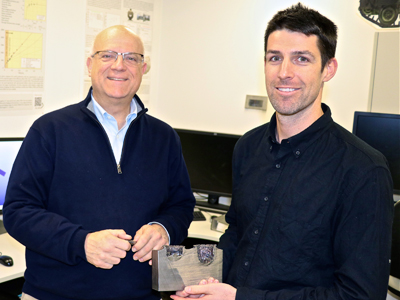Repurposing venerable models for land vehicle research

Dr William Schonberg, Professor of Civil, Architectural and Environmental Engineering at Missouri University of Science and Technology, has spent the last six months on secondment from the US to DST as Fulbright Distinguished Chair in Advanced Science and Technology. He has been working with DST Principal Scientist Dr Stephen Cimpoeru and Land Vehicles and Systems Science Team Leader Dr Shannon Ryan and colleagues in DST Melbourne.
Schonberg has more than 30 years of teaching and research experience in the areas of shock physics, hypervelocity impact and penetration mechanics. His research has been applied to a wide variety of engineering problems, including the development of orbital debris protection systems for spacecraft in low Earth orbit, kinetic energy weapons, the collapse of buildings under explosive loads, insensitive munitions and aging aircraft.
“My work has been incredibly varied,” he admits. “That’s the beauty of being a modeller. Equations are equations – sometimes you lose a few terms but one of the things I’ve been able to do is apply basic equations to many different situations.”
Focus on land vehicle attack
Schonberg’s Fulbright research originally targeted mathematical models to more accurately predict how bridges, buildings and other structures can withstand a physical attack. The focus soon zeroed in on failure modes of land vehicles under physical attack.
His Fulbright outcomes will allow DST researchers to better predict the response of vehicles to different types of impact; things they haven’t examined before, and a set of problems that he hasn’t previously had the chance to look at either.
“I’ve been able to branch out a little, and been able to use my expertise from the last 30 years in a slightly different area which is obviously a lot of fun – it has allowed me to flex my muscles a bit.”
Taking established, sometimes decades-old scientific models of how certain types of structures respond to impact, Schonberg determined how applicable they are to land vehicles today. “Physics is physics, maths is maths. Could the work people did in years past be applied to Land Division’s problems of interest? It would be nice to use what’s already out there.”
The answer is yes, at least to some extent. Schonberg has uncovered a handful of extant models whose predictions match pretty well with the test data. “That is pretty cool because many of the materials we use now didn’t exist when these models were specified, but they are sufficiently robust that with a bit of tweaking we can use them today. That’s exciting.”
The importance of models
Though his expertise is inextricably linked to explosions, Bill says he doesn’t blow things up. “That’s expensive. I’m a modeller. I look at experimental data, and work with the experimental researchers. I take a look at what’s happened after they’re done with it, and try to put it back together again.”
Researchers can’t test all materials and all projectiles under all configurations, so engineers like Bill try to understand the physics behind a problem and develop models that predict what will happen in a more general sense, for example if you use a slightly different shaped projectile or armour material. “You can’t test everything physically so you aim to create a model that’s general enough, like the ones I’ve uncovered from decades ago. Hopefully DST’s defence scientists will be able to take these models and insert them into their vulnerability and lethality assessments so that their approach can become more general and comprehensive.”

